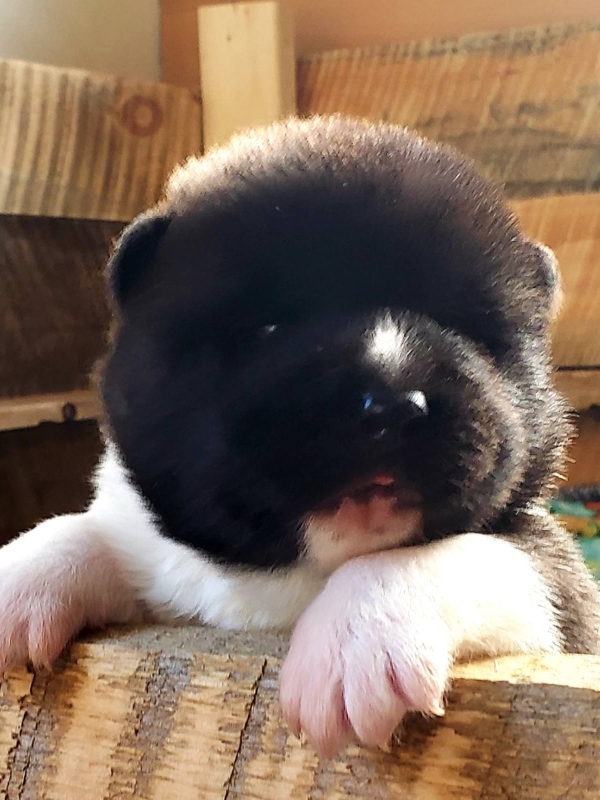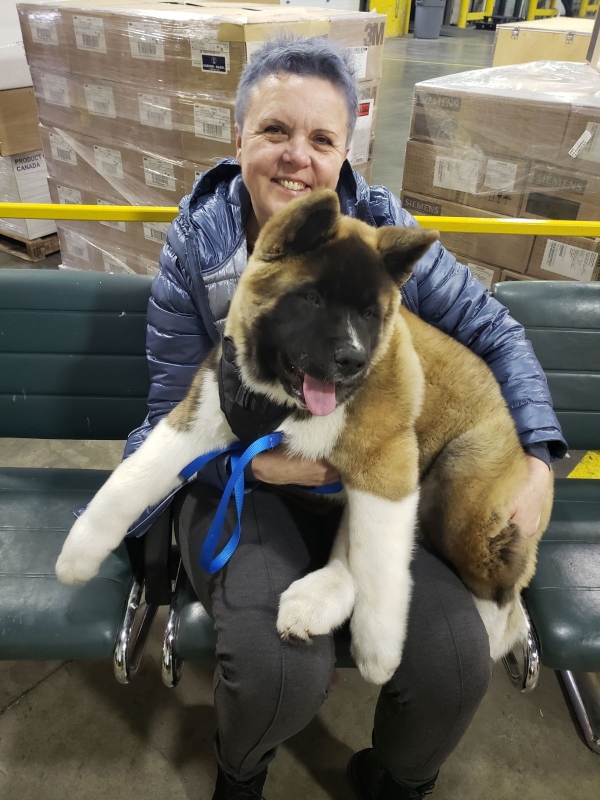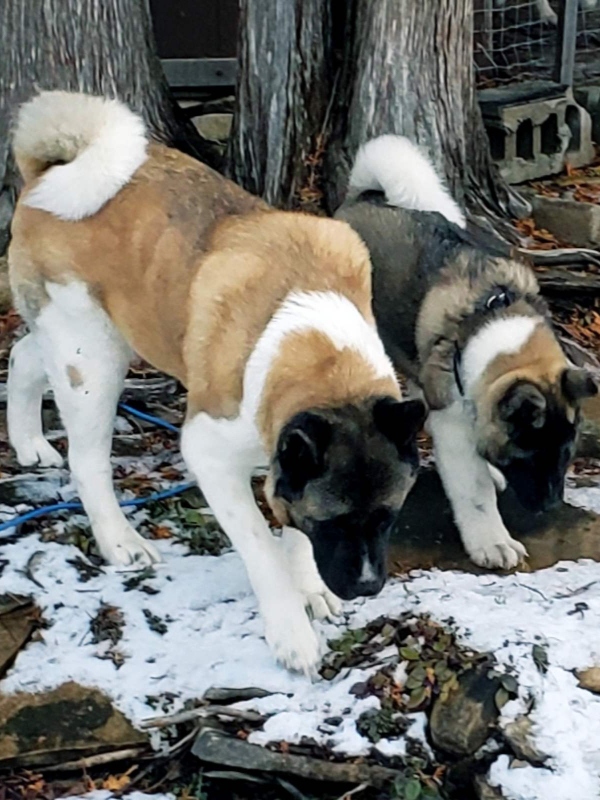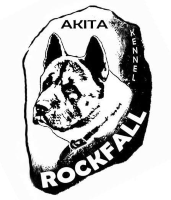About Akita Breed



Physical Appearance
The Akita always makes a lasting first impression. Akitas are large, powerful dogs with substantial bone and musculature. The broad chest and neck serve as a solid base for the Akita’s large head, the Akita’s most distinguishing feature. The broad skull and the short muzzle form a blunt triangle when viewed from above. The massive head in combination with the small triangular shaped eyes and small erect ears give the Akita an intimidating, yet dignified, expression.
The Akita is a very balanced looking dog, being only slightly longer than it is tall. The tail is curled and carried over the back, which serves to balance with the dog’s head. Typically the male Akita is substantially larger than the female. The males range in weight from about 100 to 130 pounds, while the females range from 70 to 100 pounds.
The double coat of the Akita has the appearance of the typical northern breeds. It is short to moderate in length, but very dense and consists of two layers. The undercoat is very soft and is the primary insulator, while the outer coat, or the guard hair, is slightly longer and coarser. The Akita is very well suited to the coldest of climates, and while it might not enjoy hot weather, its coat does lighten considerably in the warmer months to compensate for the heat.
Temperament
The personality of the Akita is very complex. While temperaments vary, most would agree that the Akita is very intelligent, extremely loyal, and can exhibit aggressive tendencies. The aggressive tendencies are almost exclusively towards other dogs of the same sex. Typically, Akitas are not aggressive towards people, but do have a very well developed guarding and protective instinct. Akitas also have a high and well developed prey drive. An Akita is not likely to shower affection on someone that is not a member of his family or a close friend that he sees frequently.
The loyalty and devotion displayed by an Akita is phenomenal. The typical pet Akita will follow you from room to room, yet has the uncanny ability not to be under foot. Your Akita lives his life as if his only purpose is to protect you and spend time with you. This trait is evident in the tale of Hachiko.
The Akita as a House Pet
Even though Akitas are large, hardy dogs which can withstand the elements, they have been bred for centuries to be house companions. The two most outstanding characteristics of the Akita as a house pet are that they are very clean and that they are very easy to house break. Akitas have been described as almost “cat-like,” they are so clean and odorless. This may also be one of the reasons why they housebreak so easily. Most Akitas respond so well to housebreaking that they are trained in a matter of weeks.
As far as the family children are concerned, there are a few worries. Akitas are devoted, patient friends and protectors of children. Akitas are typically very gentle with children, and it is said that Japanese mothers often left their children with only the Akitas to watch over and protect them.
Of course with a new baby entering into a home with an Akita, proper introductions and precautions should be taken until the Akita understands the situation. Young children should never be left unsupervised with large dogs of any breed, as the potential for an accident is not worth the risk.
Is the Akita the Dog for Everyone?
Right about now, you are probably thinking . . . What’s the catch? Well, the Akita is not the right dog for everyone. The person who assumes responsibility for an Akita MUST be able to take control of the dog at an early age. This means that the person has to be the dominant party in this relationship.
Dominance is more a state of mind, but you must also be prepared to physically dominate the dog if necessary. Akitas, as with most dogs, live their lives in a pack environment, whether the pack be animals or people. If you are not willing to be the leader of the pack, the Akita most certainly will. So the Akita owner must have the energy and will to keep a firm, consistent discipline as the dog matures. A little work and persistence in training in the early months with an Akita will reap you huge benefits as a well-behaved member of the family down the road.
Is the Akita the Right Dog for You?
Before you buy an Akita puppy, THINK!
What do I want my dog to be like?
How will this dog fit into my lifestyle?
What is my living situation?
Consider what your needs are and what the dog’s needs will be. Do they conflict?
Think of the dogs you’ve enjoyed owning in the past. Were they easygoing or intense? Self-willed, or independent; outgoing or reserved; placid or energetic?
Then ask yourself if you have the time needed to devote to socializing, training, and loving your dog.

The Akita is an extremely intelligent, large, energetic, and strongly territorial dog whose life is oriented toward his owners. If he is the right dog for you, he is one of the most rewarding breeds to own, but this is also a demanding breed, and should not be casually added to the household on a whim.
Will you enjoy owning an Akita?
If you are looking for a bright, sensitive, responsive dog with whom you will be able to spend time, will be able to train and will be protective and loyal and devoted to you and your family for the rest of his life, then perhaps you will enjoy owning an Akita.
The Akita can be a guard dog. He feels that one of his jobs is to protect his family. You don’t need to train him to do this; it comes naturally to him. He will be watchful of people on your property, expressing suspicion with a low rumble; Akitas are not barkers. They quickly learn to differentiate between strangers and friends. Akitas are not tolerant of other dogs especially those of the same sex.
UNDER NO CIRCUMSTANCES SHOULD AN AKITA BE ALLOWED TO ROAM THROUGH THE NEIGHBORHOOD!
The Akita, although a large dog, does not require huge amounts of exercise. It will thrive on a moderate amount of exercise and enjoys playing energetically. You will be happier and so will your dog if you choose a breed that fits into your present lifestyle. Don’t expect to change your way of life once you’ve acquired a dog.
Akitas do not shed on a continual basis; however, they do “blow their coats” about twice a year. As the new coat is beginning to grow into place, large tufts of hair will loosen. The coat can be easily removed by using an undercoat rake or wire slicker brush. The dog seems to enjoy this extra attention and if done on a regular basis as the coat is shedding, the new coat will come in more quickly.
The Akita is a working dog. The working dog group includes some of the most intelligent breeds of dogs. You’ll be amazed at how quickly he learns, and at the number of things, you can teach him.
But his intelligence carries an obligation with it. An Akita won’t be happy if left alone in a pen or house all day. A working dog enjoys life most when he is given a responsibility and a job to do, whether the job is obedience, baby-sitting, back-packing, or hunting. The Akita demands your attention and thrives on it when trained and worked regularly.
DON’T BUY AN AKITA because of the pictures you’ve seen, stories you’ve read or because they are the “IN THING”. MEET THE DOGS. Watch them at shows and visit them at home. There is a big difference between a cute eight-week-old ball of fur and a full grown adult. If, after all of that, you still want an Akita, then welcome to a most pleasurable experience.
Facts About Akitas
The Akita is a Japanese breed and in his native country, the Akita has been declared a national treasure. An Akita in a home is believed to be a symbol of good health, prosperity and good fortune. Helen Keller brought the first Akita to the United States in 1937.
Akitas do not bark unless there is a good reason. When an Akita is barking, pay attention. Akitas are natural guardians of the home and do not require any training to turn them into guard dogs. When there is a reason to protect family and property, your Akita will act to do so.
Akitas are inherently aggressive toward other animals and for this reason, they should not be allowed to run free or roam at will. You can exercise your Akita off leash when you are in an area where contact with other animals and people is unlikely.
Male Akitas show aggression toward other male dogs, and female Akitas usually will not tolerate another female. Akitas can live peacefully with a dog of the opposite sex, though some Akitas prefer being an only dog!
Akitas may consider small animals as prey and hunt them. This includes cats, rodents, birds, small wildlife and small dogs. Akitas can be raised to accept animals in residence. Some adult Akitas can even be trained to fit into a home where other animals are already established. It is, however, imperative that the Akita be closely watched around the other animals until you have established a peaceful co-existence.
Akitas are VERY food possessive. If you have other pets, you will want to be certain the Akita is given it’s own food bowl or treat well away from any other animals and that no other animal is allowed near the Akita until the food is gone.
Akitas not raised with children are not always tolerant of small children and the Akita should never be left alone with a child until you are certain you have a dog who adores all children. Often, Akitas raised with children will tolerate their own children but may not accept the neighborhood kids. As a general rule it is wise not to leave an Akita or any large dog alone with children under 12 years of age.
Akitas do not like to be teased and can respond by biting. Some children are allowed to treat animals unkindly, a behavior that often leads to cruelty to animals. These children should be kept away from an Akita, whose large size and hunting instincts can endanger the child’s life.
Akitas like to take charge – an inherited trait from their wolf ancestry – and may at some time, challenge you for the dominant position. This behavior cannot be tolerated and a firm, consistent correction should be your immediate response. Akitas with good temperament accept discipline well – not beating, but intelligent discipline. A good scruff shaking is an effective form of discipline for an Akita. frequently, a firm verbal command will get your point across.
Akitas should be obedience trained BY their owner and not sent away to school like other breeds! A good obedience class, perhaps beginning with puppy kindergarten, will guarantee you a firm bond with your dog and a well behaved dog.. Remember though, Akitas are extremely intelligent and tend to get bored easily. They learn quickly, so short training periods are suggested. This keeps the dog from becoming bored. Akitas are also very stubborn and when the dog thinks it’s a waste of time to “sit” or “stay” one more time, he will simply walk away! Obedience training requires patience!
Some Akitas are talkers! They may grunt, groan and mumble to entertain themselves and you. This conversational verbalizing IS NOT growling and should not be interpreted as a growl, which sounds quite different. Akita “talking” is an endearing trait and should not frighten you. After living with your dog, you will easily distinguish between talking and growling.
Most Akitas enjoy carrying things around in their mouth, including your wrist! They may take you by the wrist to lead you to the cookie cupboard or to their lead. It is not an aggressive act, it is an endearing trait. Try allowing your Akita to bring in the newspaper or the mail. They love to do these types of jobs.
Akitas are very family-oriented and are not happy when kept apart from the family. If you do not plan on having your dog live with you inside both your home and yard, you should not seriously consider an Akita for a pet.
Akitas are not hyperactive and fit into a sedentary household, but for optimum health for both YOU and your Akita, regular exercise is important.
Akitas will live from 10-14 years with good care and proper nutrition.
Hypothyroid disease affects a large percentage of the breed and is easily treated by twice-daily hormone replacement therapy. A simple blood test, including a T3 and T4 thyroid levels test, will determine the existence of the condition. The symptoms may include one or all of the following: skin and coat problems, sudden onset aggression, itching, lethargy, musky odor. Before treating skin conditions with any drugs, have your vet check for sarcoptic mange, sebaceous adenitis, and Hypothyroid disease. Other diseases found in Akitas include Progressive Retinal Atrophy (blindness) manifested by impaired night vision, hip and elbow problems, autoimmune diseases, degenerative myelopathy, and some blood disorders, though these are not common problems in the breed.
Akitas require good quality meat and bone meal-based food and do not thrive as well on soybean-based dog foods. Akitas 7 years and older should be fed one of the commercial LITE foods to lessen the onset of kidney disease which is a problem in older Akitas. (Akita Rescue Society of America)
